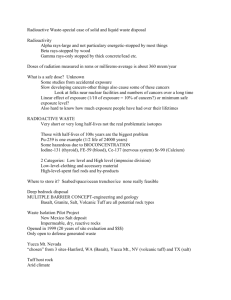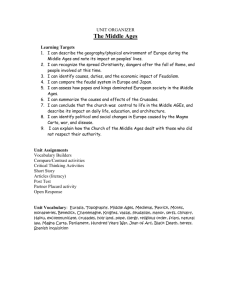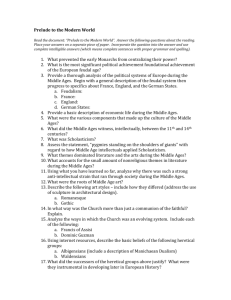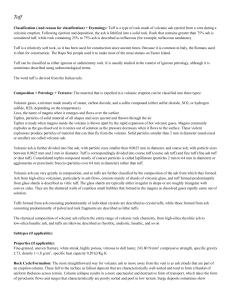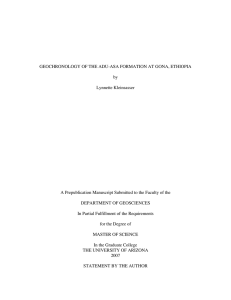Rahn_Meinert_Talk - SWISS GEOSCIENCE MEETINGs
advertisement
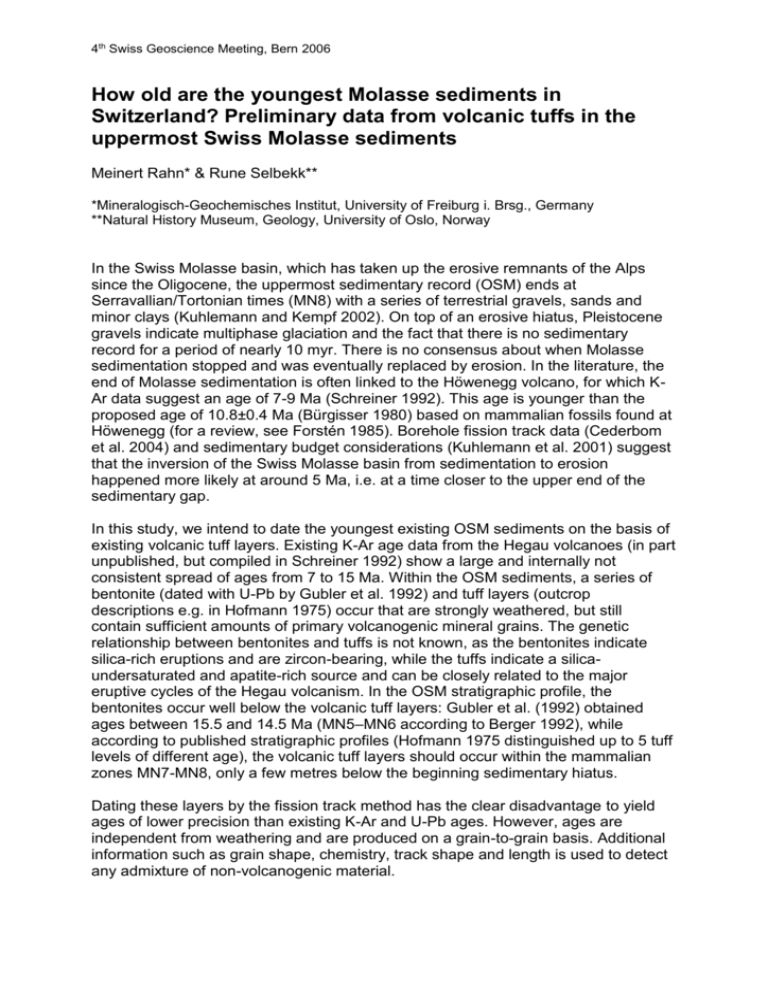
4th Swiss Geoscience Meeting, Bern 2006 How old are the youngest Molasse sediments in Switzerland? Preliminary data from volcanic tuffs in the uppermost Swiss Molasse sediments Meinert Rahn* & Rune Selbekk** *Mineralogisch-Geochemisches Institut, University of Freiburg i. Brsg., Germany **Natural History Museum, Geology, University of Oslo, Norway In the Swiss Molasse basin, which has taken up the erosive remnants of the Alps since the Oligocene, the uppermost sedimentary record (OSM) ends at Serravallian/Tortonian times (MN8) with a series of terrestrial gravels, sands and minor clays (Kuhlemann and Kempf 2002). On top of an erosive hiatus, Pleistocene gravels indicate multiphase glaciation and the fact that there is no sedimentary record for a period of nearly 10 myr. There is no consensus about when Molasse sedimentation stopped and was eventually replaced by erosion. In the literature, the end of Molasse sedimentation is often linked to the Höwenegg volcano, for which KAr data suggest an age of 7-9 Ma (Schreiner 1992). This age is younger than the proposed age of 10.8±0.4 Ma (Bürgisser 1980) based on mammalian fossils found at Höwenegg (for a review, see Forstén 1985). Borehole fission track data (Cederbom et al. 2004) and sedimentary budget considerations (Kuhlemann et al. 2001) suggest that the inversion of the Swiss Molasse basin from sedimentation to erosion happened more likely at around 5 Ma, i.e. at a time closer to the upper end of the sedimentary gap. In this study, we intend to date the youngest existing OSM sediments on the basis of existing volcanic tuff layers. Existing K-Ar age data from the Hegau volcanoes (in part unpublished, but compiled in Schreiner 1992) show a large and internally not consistent spread of ages from 7 to 15 Ma. Within the OSM sediments, a series of bentonite (dated with U-Pb by Gubler et al. 1992) and tuff layers (outcrop descriptions e.g. in Hofmann 1975) occur that are strongly weathered, but still contain sufficient amounts of primary volcanogenic mineral grains. The genetic relationship between bentonites and tuffs is not known, as the bentonites indicate silica-rich eruptions and are zircon-bearing, while the tuffs indicate a silicaundersaturated and apatite-rich source and can be closely related to the major eruptive cycles of the Hegau volcanism. In the OSM stratigraphic profile, the bentonites occur well below the volcanic tuff layers: Gubler et al. (1992) obtained ages between 15.5 and 14.5 Ma (MN5–MN6 according to Berger 1992), while according to published stratigraphic profiles (Hofmann 1975 distinguished up to 5 tuff levels of different age), the volcanic tuff layers should occur within the mammalian zones MN7-MN8, only a few metres below the beginning sedimentary hiatus. Dating these layers by the fission track method has the clear disadvantage to yield ages of lower precision than existing K-Ar and U-Pb ages. However, ages are independent from weathering and are produced on a grain-to-grain basis. Additional information such as grain shape, chemistry, track shape and length is used to detect any admixture of non-volcanogenic material. 4th Swiss Geoscience Meeting, Bern 2006 Preliminary dating results on apatite fail to distinguish between different levels or eruption events. However, single grain age and track length distributions in apatite clearly reveal non-volcanogenic detritus, and by statistical decomposition of single grain age distributions the volcanic ages can be extracted. Apatite track lengths from pure tuffs indicate rapid cooling, while track length distributions from tuff layers with sedimentary detritus have shorter mean track lengths. Those samples with shorter mean track lengths also show the presence of minor to major amounts of old detritus with typical Palaeogene to Late Cretaceous apatite ages. The volcanic FT ages vary between 10 and 11.5 Ma. For the Höwenegg volcano, one dated tuff layer reveals a 10 Ma age, which is significantly older than published K-Ar ages, but within error of the suggested stratigraphic age. REFERENCES Berger, J.-P. (1992): Correlative chart of the European Oligocene and Miocene: Application to the Swiss Molasse Basin. Eclogae geologicae Helvetiae 85: 573-609. Bürgisser, H.M. (1980): Zur Mittel-Miozänen Sedimentation im nordalpinen Molassebecken: das ‘Appenzellergranit’-Leitniveau des Hörnli-Schuttfächers (OSM, Nordostschweiz). PhD thesis, ETH Zürich: 196p. Cederbom, C.E., Sinclair, H.D., Schlunegger, F. & Rahn, M.K. (2004): Climateinduced rebound and exhumation of the European Alps. Geology 32: 709-712. Forstén, A. (1985): Hipparion primigenium from Höwenegg/Hegau, FRG. Annales Zoologici Fennici 22: 417-422. Gubler, T., Meier, M. & Oberli, F. (1992): Bentonites as time markers for sedimentation of the upper freshwater molasses: Geological observations corroborated by high-resolution single zircon U-Pb ages. SANW annual assembly, Basel, Abstract volume: 12-13. Hofmann, F. (1975): Vulkanische Tuffe auf dem Wellenberg E von Frauenfeld und neue Funde auf dem thurgauischen Seerücken. Eclogae geologicae Helvetiae 68: 311-318. Kuhlemann, J., Frisch, W., Dunkl, I. & Székely, B. (2001): Quantifying tectonic versus erosive denudation by the sediment budget: the Miocene core complexes of the Alps. Tectonophysics 330: 1-23. Kuhlemann, J. & Kempf, O. (2002): Post-Eocene evolution of the North Alpine Foreland Basin and its response to Alpine tectonics. Sedimentary Geology 152: 45– 78. Schreiner, A. (1992): Geologische Karte 1:50 000 von Baden Württemberg Erläuterungen zu Blatt Hegau und westl. Bodensee. Geologisches Landesamt Baden-Württemberg, Freiburg, Stuttgart: 290p.
